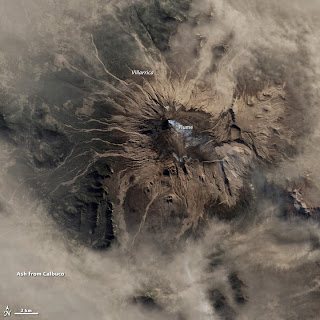The bluebirds are a group of medium-sized birds in the genus Sialia of the thrush family (Turdidae). They are known to be mostly insectivorous, but can be omnivorous. Gardeners like to have them around since they can be voracious in their appetite for insects. They are blue with rose beige underside. Female birds are less brightly colored than males, although color patterns are similar and there is no noticeable difference in size as can be seen in the Wiki image below.
The species I photographed is an Eastern Bluebird (Sialia sialis), which is the state bird of Missouri and New York.
Bluebirds are territorial and prefer open grassland with scattered trees. This is similar to the ecosystem of many other species. By the 1970s, their numbers had declined by as much as 70% due to unsuccessful competition with house sparrows, woodpeckers, and starlings. Introduced species of competitive birds caused most of the decline in numbers. However, in the last decade volunteers have established and maintained bluebird trails and platforms, which has helped these beautiful birds to increase their population numbers. The range for the Eastern Bluebird is shown below.
Eastern bluebirds are very social birds. At times, they gather in flocks of a hundred or more. However, they are territorial during the breeding season and may continue to defend a feeding area throughout the winter. Mating occurs in the spring and summer. A mature female typically raises two broods each season (March through August). Males identify potential nest sites and attract prospective females by singing, flapping his wings, and placing some material in a nesting box or cavity. If the female accepts the male and the nesting site, she alone builds the nest and incubates the eggs.
Nests are constructed in trees within abandoned woodpecker holes or other cavities that provide adequate protection (usually several feet above ground). The female takes around 10 days to complete the nests, which are small, cup-like structures lined with grass, feathers, stems, and hairs.
Each female lays three to seven light-blue or, rarely, white eggs. The female incubates the eggs, which hatch after 13 to 16 days. The young cannot care for themselves upon hatching. The female broods the chicks for up to seven days after hatching. Fledglings then leave the nest 15 to 20 days after hatching.
Both parents cooperate in raising the young, which they feed a diet consisting almost entirely of insects. Some young stay around the nest to help raise another brood. Fledglings are grayish in color, with speckled breasts. The blue color becomes much more prominent and the speckles on their breasts disappear as they mature. Bluebirds may begin breeding the summer after they are hatched. Eastern bluebirds can live for 6 to 10 years. The record lifespan for a bluebird was 10 years and five months. However, a majority of bluebirds die within their first year of life. Starvation and freezing can threaten young bluebirds, but most threats come from other animals, including humans. Natural predators of eggs and nestlings can include eastern chipmunks, flying squirrels, American black bears, fire ants, and raccoons. Bluebirds of all ages (including adults) are threatened by rat snakes, racers, and American kestrels. Introduced species such as European starlings, house sparrows and domestic cats pose a major threat to bluebird nests, as well, with the cat being a serious predator of adult bluebirds and the other birds being competitors for nesting sites. Non-nesting adults face predation with all native species of falcons, owls, and most varieties of hawks (particularly in the Accipiter genus). When approached by a predator, males make a song-like warning cry. If a male is not present, a female will begin to sing, hoping to attract a protective male back to the territory. Both males and females also flick their wings and warble when predators are nearby, but losses are often heavy when a persistent predator finds their nest.
Eastern bluebirds live in open country around trees that have little understory and sparse ground cover. Original habitats probably included open, frequently burned pine savannas, beaver ponds, mature but open woods, and forest openings. Today, they’re most common along pastures, agricultural fields, suburban parks, backyards, and even golf courses. This bird also occurs across eastern North America and south as far as Nicaragua. Birds that live farther north and in the west of the range tend to lay more eggs than eastern and southern birds
Identification information from the website http://www.allaboutbirds.org/guide/Eastern_Bluebird/id is below.
-
Size & Shape
The Eastern Bluebird is a small thrush with a big, rounded head, large eye, plump body, and alert posture. The wings are long, but the tail and legs are fairly short. The bill is short and straight.
-
Color Pattern
Male Eastern Bluebirds are vivid, deep blue above and rusty or brick-red on the throat and breast. Blue in birds always depends on the light, and males often look plain gray-brown from a distance. Females are grayish above with bluish wings and tail, and a subdued orange-brown breast.
-
Behavior
Eastern Bluebirds perch erect on wires, posts, and low branches in open country, scanning the ground for prey. They feed by dropping to the ground onto insects or, in fall and winter, by perching on fruiting trees to gulp down berries. Bluebirds commonly use nest boxes as well as old woodpecker holes.
CITES:
http://en.wikipedia.org/wiki/Bluebird
http://en.wikipedia.org/wiki/Eastern_bluebird
Snowmanradio, http://commons.wikimedia.org/wiki/File:Sialia_sialis_-Michigan,_USA_-pair-8c.jpg
rbrausse: http://commons.wikimedia.org/wiki/File:Sialia_sialis_distribution.png
Вasil at the English language Wikipedia: http://commons.wikimedia.org/wiki/File:Bluebird_eggs.png



































































